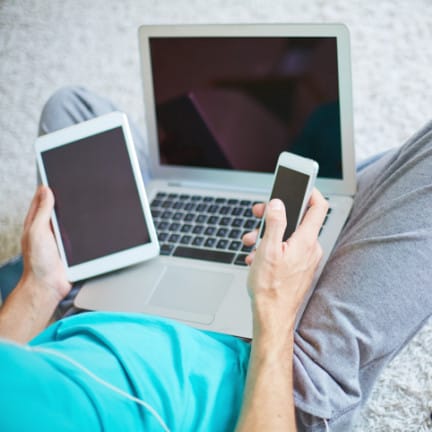Technology addiction: fact or fiction?
We love the instant, constant gratification of playing with our smart phones, tablets and smart watches, but how bad for us are they really? While some experts call it a serious addiction, others are less sure.

Whether it’s the latest iPhone 6 or the newest Apple Watch, the growing connection we have to the Internet is driving our addiction to technology, experts say.
Monash University School of Psychological Sciences Senior Research Fellow Dr Adrian Carter said addictions to technology were similar to other well-known addictions.
“People tend to use whatever device they have in order to surf the internet,” Dr Carter said.
“Often their reason for doing so relates to other forms of behaviour that have been linked to addiction, such as viewing pornography, shopping online and gambling.”
But Dr Carter said people were addicted to the capabilities a device provided, rather than the technology itself.
“Australians are spending an increasing large amount of their time in front of computer screens, whether they be desktop computers, iPads, smartphones or, more recently, Apple watches … but it is not necessarily the technology that is addictive, but the activity that the technology provides,” Dr Carter said.
Monash University Professor of Education and digital media researcher Neil Selwyn said self-diagnosing what we believed was an addiction to technology trivialised proper addictions.
“Everyone loves having a label … it covers the complexities of technology use,” he said.
Addiction is often used to describe a person’s fixation with some form of drug or narcotic, and Prof Selwyn said technological addiction might stretch the definition.
"It’s a big leap to say that those sorts of addictions are being completely replicated with our use of technology,” he said.
These addictions might just be a habit that engulfed an individual who spent a large proportion of their day on a technological device, whether a computer, smartphone or tablet.
Dr Carter said that just because we have trouble disengaging with a behaviour does not mean that we are addicted to it,” he said.
Academics and clinicians are still undecided on whether computer addictions, such as gaming addictions or internet addictions, are real psychiatric conditions and should be included in the next edition of the Diagnostic and Statistical Manual of Mental Illness, the standard classification of mental disorders used by mental health professionals in the United States and more widely.
Prof Selwyn said technology use was individually contextualised, so that “what is useful to you might not be useful to someone else”.
The Pew Internet Report found 30 per cent of smartphone owners used their phone to take a class or get educational content.
Extensive use didn't mean a person was addicted, Dr Carter said.
“Many people are required to spend a large proportion of their waking day on a computer for their work, as I do, but we do not consider this an addiction,” he said.
Reducing technology use
The 7til7 campaign encouraged Australians to disconnect from 7pm to 7am each day from Sunday, April 19 to Saturday, April 25.
It raised $15,481.48 for Headspace National Youth Mental Health Foundation.

7til7 Marketing communications manager Amy Martin said the aim was not to say technology was bad, but to make time for other aspects of our lives.
“We are getting very distracted these days, and not making time out for our family and ourselves,” Ms Martin said.
Almost 120 participants took the challenge and chose to actively disconnect.
Prof Selwyn said the 7til7 campaign showed people were not actually addicted to their technology and devices.
“If you were addicted, you would not be able to take part in this challenge ... much like you cannot give up heroin for seven days just because you feel like it,” he said.
“[It] just shows the addiction thing is nonsense because you won't be able to do that if you were properly addicted.”
A research study conducted at the University of Amsterdam found an estimated 5 per cent of today’s youth experienced symptoms of social media addiction.
This could range from spending increased amounts of time thinking about it, needing to spend substantial amounts of time to feel the desired effect, or an inability to reduce usage.
These behaviours might be a result of other lifestyle factors, according to Dr Carter.
“Some people are more vulnerable to developing an addiction, possibly due to traumatic experiences or personality types,” Dr Carter said.
“Some people (around 17 per cent) who take a dopamine-like medication for their Parkinson’s disease will develop a compulsive behaviour as a result of their medication.”
This may cause addiction-like behaviour in technology use.
In light of this campaign, Prof Selwyn said there was an alternative to "going cold turkey for seven days".
Individuals should aim to reconfigure their devices in a way that maximised time for social interactions and other daily needs, he said. They could do this by setting alerts, filters or time limits.





